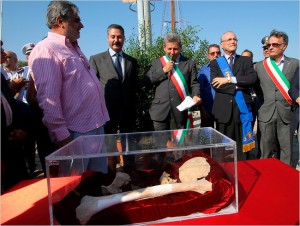 Saturday a few pieces of Caravaggio (maybe) were placed reverently on red velvet pillow in a crystal urn and carried to Porto Ercole on a tall ship in tribute to the final sea voyage that brought Caravaggio to Porto Ercole in 1610. Some fragments of his skull, a piece of femur, and part of the base of his spine were given a hero’s welcome by the crowd.
Saturday a few pieces of Caravaggio (maybe) were placed reverently on red velvet pillow in a crystal urn and carried to Porto Ercole on a tall ship in tribute to the final sea voyage that brought Caravaggio to Porto Ercole in 1610. Some fragments of his skull, a piece of femur, and part of the base of his spine were given a hero’s welcome by the crowd.
Some people, however, are less than gruntled at the spectacle and at the weak scholarship/shameless tourism-grubbing behind it.
“It’s a put-on that offends the intelligence of people,” said Vincenzo Pacelli, an art historian and scholar of Caravaggio’s final days, accusing the committee of perpetrating an urban legend.
Other critics suggested that as the Italian government seeks to exploit the economic potential of the country’s cultural resources, marketing is trumping serious study.
“In the 400th anniversary of Caravaggio’s death, this committee has concocted a compelling discovery thinking it will attract tourists,” said Tomaso Montanari, who teaches 17th-century art at the University of Naples. “It’s all very depressing.”
Since there was no solid DNA to compare, we really don’t know if it’s him. Then there’s the question of whether exhuming bones of dead luminaries is a worthy endeavor in the first place. After all, we still don’t quite know what killed him. Mr. Vincenti, the leader of the project, thinks Caravaggio died of lead poisoning from handling lead paints, the committee that ran the project pins it on sunstroke hammering his syphilis-weakened body.
Vincenti doesn’t bother to deny the drama is good business for the area. Quite the opposite, in fact.
Mr. Vinceti did not seem to be arguing on Saturday when he said: “It doesn’t end here, Tuscany and Lombardy are about to launch a cultural tourism initiative so that Caravaggio lovers can come to Italy and revisit the places where he lived. We need to promote the great wealth that Italy has in its art and culture.”
Hey, we all gotta make a living, amirite?
The Scientist part of me is as bemused by the grumpy folks quoted, but the art lover in me wished I could have been there to cheer Caravaggio’s symbolic return. Whether it was him or not, the emotional accolade is still fiting.
There is also a cynical part of me that thinks that part of him should go to jail, but I wont dwell on that!
If anything, this highlights what a strong emotional impact Caravaggio makes on people, even Centuries on. With Leonardo, Michelangelo, we obsess over the images they created. We have that with Caravaggio too, but the man himself is as riveting a topic as his art.
H Niyazi
threepipeproblem.blogspot.com
The artist as hero/madman/outcast/rebel is so deeply ingrained in our collective consciousness now that we almost crave characters like Caravaggio in our canon.
I find the random bones a little disconcerting, though. I think I’d find them more affecting if they were more recognizable parts.
Maybe they’ll build a grand tomb for him that will become a major tourist destination. It worked for the Venetians when they stole the remains of St. Mark from Alexandria.
Oh, I’m pretty sure they’re already thinking along those lines. We’ll see if anybody has the money to make it happen for a while, though.
Caravaggio today is famous mainly for being famous. You know that point has been reached when his very bones are venerated. (And I can’t quite believe that lead poisoning did for him – he can’t have handled any more lead-based paint than his contemporaries, in fact rather less considering his age at death).
I don’t find the lead poisoning theory of death to be enormously compelling either. Some knights in armour did repeatedly stab him, after all. That seems more likely to be a proximate cause of death.